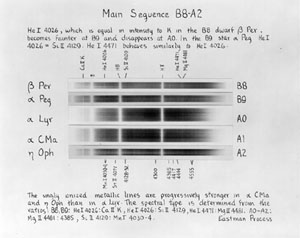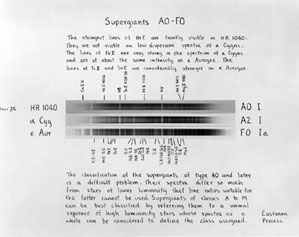


11. The A Stars
Of all spectral types from B to M the stars of class A are the most difficult to classify. The spectral lines are weak and may be greatly broadened; in addition, the frequency with which peculiar spectra are encountered makes any sort of accurate classification a difficult problem.
 |
| High resolution image |
When spectra of very low dispersion are used, the classification seems to be a rather simple matter. If the C-stars and peculiar objects are omitted from consideration, the growth of K with respect to the hydrogen lines from B9 to F0 appears to be smooth and rapid and a sensitive criterion of spectral type. When spectra of higher dispersion are examined, however, it is seen that the intensity of K is by no means a unique indicator of spectral type. Stars are frequently encountered whose spectra have many characteristics of class F, while the K line indicates a class of A2 or A3. To make the problem even more difficult, it appears that the colors of these stars are in disagreement with the type derived from the K line and probably correspond to the later class indicated by certain other spectral features.
From investigations of several galactic clusters by Titus it appears that these pseudocomposite spectra may have a high space frequency and a corresponding importance in problems of stellar astronomy. As the problem of their classification is of considerable importance, the spectra of several of the brightest objects of this class will be described in detail later.
In addition to these ``metallic-line'' A stars, there are several other groups of peculiar spectra. Stars of these classes form only a small fraction of the total, and their peculiarities can be recognized in general on low-dispersion spectrograms. It is possible, then, to eliminate them from problems in which mean absolute magnitudes or color indices are used.
The B9-F0 stars have been reclassified with the particular object of
obtaining as pure a temperature sequence as is possible. In the early
A subdivisions the general increase in intensity of the enhanced lines
of iron and titanium appears to be closely correlated with color,
while for the later subdivisions the Mn I blend near
 4032 appears to
be the most useful index of type on spectrograms of the dispersion
used. The supergiants are discussed in another place.
4032 appears to
be the most useful index of type on spectrograms of the dispersion
used. The supergiants are discussed in another place.
 |
| High resolution image |